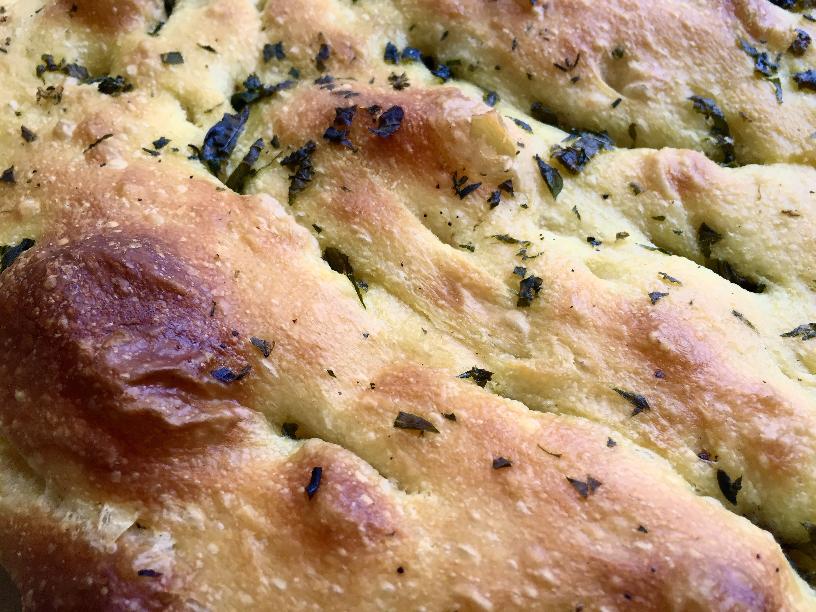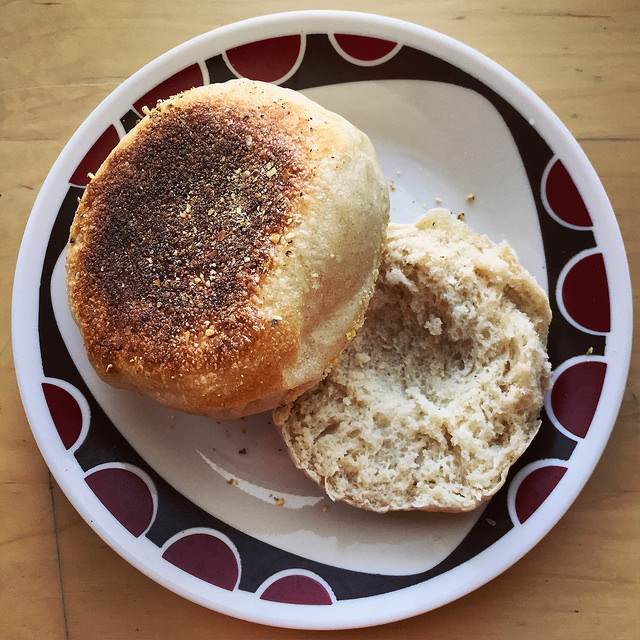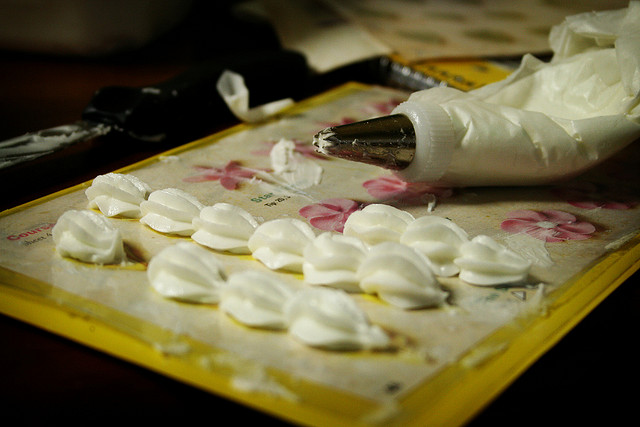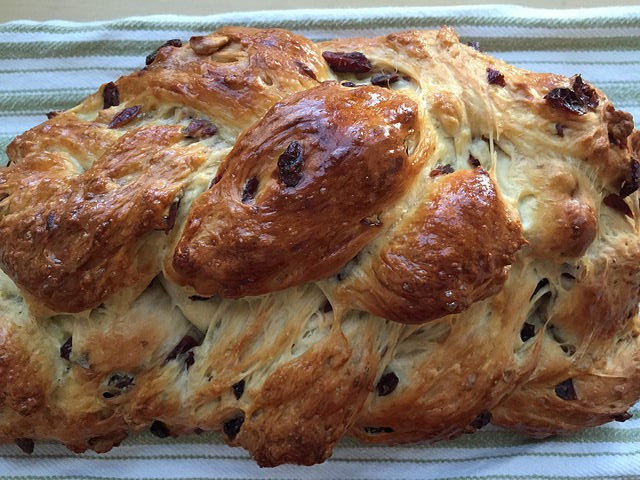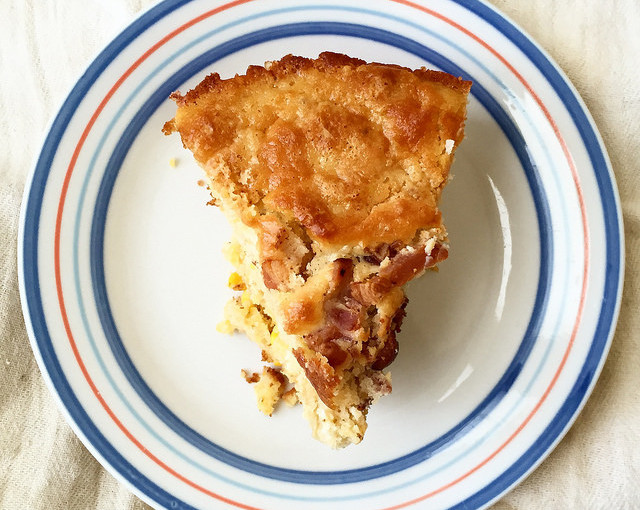Focaccia is the fun cousin of ciabatta; it has a wet, long-fermenting dough that bakes up to a light, somewhat flat but very bubbly bread — plus a healthy dose of herb-infused olive oil. It doesn’t look neat and tidy, but bakes into a landscape of olive-oil filled valleys and air bubble peaks. Flavor-wise, focaccia plays second fiddle to no one. It’s great for dipping in oils and sauces, but it’s baked with so much rich olive oil flavor that it holds its own as well. Olive oil plays a huge part in making this focaccia recipe great. A healthy coating pools in the divots on the top side of the bread, and runs down the sides and sizzles underneath during baking for a thick, crispy bottom crust. If you’re looking for a great base for a deep dish pizza crust, this might be the perfect recipe.
A Slow Fermentation Masterpiece
This focaccia feels like the epitome of Reinhart’s slow fermentation baking philosophy. Be forewarned that a significant amount of proofing time is required on both days of the bread’s preparation.When all is accounted for, it requires a bit over 5 hours of room temperature proofing and a long night in the refrigerator. The time it takes for the dough to reach bubbly perfection is worth it, however; the final product has a fantastically complex taste and really lets the flavor of the yeast stand out. Much like ciabatta, a very wet poolish-style starter is the foundation of this loaf. In this case, the poolish is all that’s used, as no other ingredients are added on day 2.
Any number of toppings can be used to dress up this loaf, but I used a simple olive oil infused with herbs and garlic. I found that an extra sprinkling of salt over the top of the focaccia after baking immensely improved the overall balance of the flavor. I had a really hard time leaving the fresh, warm slices alone long enough to take photos.
Focaccia with Basil Garlic Oil
Yields one very large focaccia loaf. Slightly adapted from Peter Reinhart’s The Bread Baker’s Apprentice.
Focaccia Ingredients
- 5 cups (22.5 oz) bread flour
- 2 tsp salt
- 2 tsp instant yeast
- 6 T olive oil
- 2 cups water, room temp
- Extra olive oil for drizzling
Herb Oil Ingredients
- 1/2 cup olive oil (doesn’t have to be extra virgin)
- 1 large garlic clove, smashed
- 2 T fresh basil leaves
- 1 tsp fresh marjoram
- 1 tsp fresh thyme
- A few pinches each of salt and pepper
Note: Any combination of fresh herbs will do for this, depending on your flavor preference.
Instructions
- Preparing the Dough: The day before you want to bake the focaccia, assemble the dough. Stir together the flour, salt, and yeast in a large mixing bowl, then add the water and olive oil. Stir with a wooden spoon (or your hand) until the dough comes together. continue mixing or kneading for about 5 minutes. The dough should be smooth and loose, but not too sticky. It will stick to the bottom of the bowl, but should clear the sides as you mix.
- Sprinkle flour on a counter to make an 8×8-inch bed for the dough. Transfer the dough into the bed and dust liberally with flour, patting (as best you can– the dough will be very loose and uncooperative) into a rectangle. Wait 5 minutes for the dough to rest.
- Pulling the dough from either side, gently stretch it to about twice its length, then fold it over itself into thirds, as if you were folding a piece of paper to put in an envelope. Mist with spray oil and dust with flour, then cover with plastic wrap and let sit for 30 minutes.
- After 30 minutes, repeat process. Let sit again for 30 minutes.
- After the second 30 minute period, repeat the stretching one last time and then let sit for an hour. It won’t rise, but it will swell and spread significantly (Just to recap, that’s 3 “stretches” total).

- Proceed with shaping; line a baking sheet with parchment, then drizzle some olive oil over the parchment. spread it around with a spatula (or your fingers) so that most of the parchment is covered. Shape the dough into a rough rectangle, spray lightly with oil, and cover with plastic wrap.
- Refrigerate overnight.
- Making the Herb Oil: You can do this the night you make the dough, or right before you prepare the dough for its final proofing. Heat the olive oil to about 100°F in a small saucepan, and stir in chopped herbs and garlic clove. Keep over low heat for a few minutes, stirring occasionally. Remove from heat and let cool slightly, then remove the garlic clove and discard (if you prefer, mince the garlic before adding it to the oil and leave it in. You can double the recipe if you wish, and keep the extra oil in the refrigerator.

- Baking the Focaccia: The next day, remove the dough from the fridge 3 hours before you’re ready to bake. Right after removing the pan from the fridge, drizzle half the herb oil over the bread, then press down with your fingers to create dimples. It’s important not to depress the entire loaf; you want to retain some of those air bubbles to get the desired texture (see below). Drizzle the rest of the herb oil over the bread, before re-covering (loosely) with plastic wrap. Let rise for 3 hours at room temperature.

- About 20-30 minutes before you want to bake the loaf, preheat the oven to 500°F.
- When you’re ready to bake, uncover the bread carefully. It will probably spread to cover most of the pan, but don’t worry if it doesn’t. Place the pan in the oven and turn the heat down to 450°F. Bake for 10 minutes, then rotate pan 180° and bake for another 5-10 minutes, or until lightly golden brown (I baked mine for about 7 minutes after turning).

